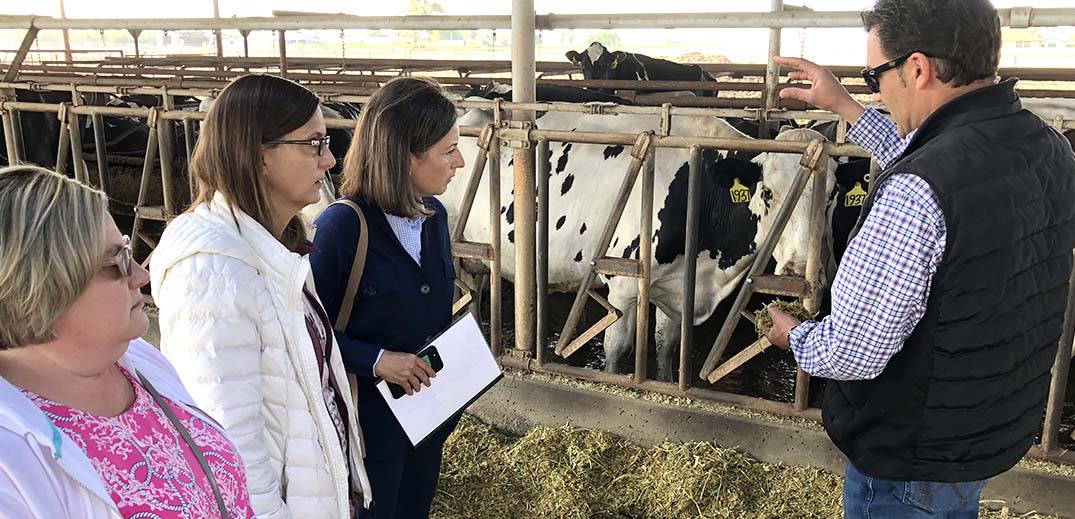As the mother of two critical young adults in the middle of an ever-growing climate crisis, I am highly motivated to advance our regeneration agenda, to make a positive difference for people and planet.
Leading our efforts here, means I have the privilege of seeing our on-the-ground efforts first-hand. My calendar can include farm visits to study regenerative agriculture across sectors, trips to operations incorporating renewable energy, brand meetings to discuss packaging innovation or how to best engage consumers, and always, always, evaluating our progress toward ambitious targets. It's a journey, but we're relentless. And I couldn't be prouder of the people behind our progress.
What role can we play in reducing greenhouse gas emissions (GHG)?
The food sector accounts for around a third of all GHG emissions, which means we have a vital role to play in limiting the impacts of climate change.
Our path:
Last year, we reduced Nestle's greenhouse gas emissions by more than 13% compared to our baseline. We are working to reduce our emissions by 20% by 2025 and achieve net zero by 2050.
How do we get there?
Tapping every opportunity. For instance, we partner with organizations like the Earthworm Foundation on a Forest Positive strategy to help protect and restore forests and natural habitats in our supply chain.
- The Rimba collective is a powerful example of the strategy in action to help end deforestation in the palm oil industry. The project aims to protect 93 000 hectares and restore 23 200 hectares of Indonesian forest by end of 2025. As of September, our teams have contributed to protecting 29 000+ hectares in the area so far.
Then, we work directly with dairy farmers for the best way to reduce emissions end to end, from feed to manure.
Another example is a creative approach to recipe reformulation. When possible, we redesign product recipes to maintain the quality and taste of our products while reducing emissions. Last year, we reduced nearly one million metric tons of CO2e this way.
- In Nigeria, we launched a nutritious Nido instant powder that combines milk with locally sourced soy. It meets consumers' demand for a source of proteins, fibers, calcium, and iron, while also having a lower carbon footprint.
Why does regenerative agriculture matter?
Across farms on all continents, I have seen the power of regenerative agriculture practices firsthand. It can improve soil health, capture carbon, enhance biodiversity, and, above all, improve the resilience of farming communities.
Our path:
15% of our key ingredients are sourced from farmers adopting regenerative agricultural practices, more than double the portion last year!
How are we collaborating on localized regenerative projects?
- In the UK, our Nestlé Purina PetCare team and other businesses joined with a group of forward-thinking wheat farmers called the "High Suffolk Farm Cluster" to put the landscape at the center of their operations. The aim: improve the resilience of wheat in the face of climate change, protect biodiversity, regenerate the land, and secure high-quality food. It is a win-win for farm owners, wildlife, and customers.
- Meanwhile, our coffee teams are progressing on the Nescafé Plan 2030 (pdf, 100Kb), which has reached 277 000 farmers in 27 origins. Coffee growers were trained on regenerative agriculture principles, and over 21 million coffee plantlets were distributed last year to support renovation of their coffee farms. They also planted three million forest and fruit trees to help improve the resilience of their farms and increase local biodiversity.
What is the future of packaging?
We are working toward a future where none of our packaging ends up in landfill or as litter in the environment. Reducing waste, managing recovered packaging materials, and increasing recyclability and circularity are musts.
Our path:
We're working toward a goal of reducing our use of virgin plastic by one-third by 2025. So far, we're using nearly 15% less than in 2018. As of 2023, over 86% of our packaging is recyclable, reusable, or compostable.
Which brands are leading packaging innovation?
Many that I'm excited about! A few examples include:
- Nescafé - In Latin America, we redesigned our single-serve stick packs for coffee, improving the coffee weight-to-packaging-surface-area ratio. This change has reduced the plastic used for the product by 44 tonnes. In China, our teams lightened the bottles for our ready-to-drink coffee. That simple change saves over 1 700 metric tonnes of plastics annually.
- Nesquik - A collaboration with Circolution in Germany has led to over 60 grocery stores offering Nesquik in reusable stainless-steel packaging. Best part? It is compatible with the existing deposit return and cleaning infrastructure and consumers like it!
How do you scale up renewable electricity?
While attending COP28, I had the opportunity to visit our Dubai factory where 15 000 solar panels help power beloved brands like Nescafé and Maggi. Both the COP28 conversations and this unforgettable on-the-ground experience solidified my conviction that renewable energy is essential, both for our industry and the communities we serve.
Our path:
We're making strong progress to source 100% renewable electricity across all our sites by 2025. In 2023, over 91% of the electricity we source at our manufacturing facilities is already from renewables.
Where does our progress come from?
A great contributor to last year's progress in renewable energy sourcing came from Texas, USA. A 600-hectare solar project, owned by Enel North America, will add 208 MW of solar electricity to the US grid. We will purchase 100% of the renewable electricity generated for 15 years. That solar power will reduce carbon emissions by about 126 000 tonnes each year in facilities where beloved brands like DiGiorno pizza, Stouffer's Nesquik, Purina Pro Plan pet food and Tidy Cats cat litter are made.
Final thoughts
There is no one-size-fits-all approach to future-proofing our food systems. That said, investing in sustainable innovations, supporting local communities, and empowering future generations of farmers, is a strong direction to take toward a more resilient future. And in the process, we can nourish our communities and safeguard the well-being of our planet.











